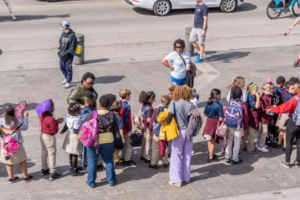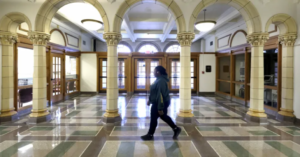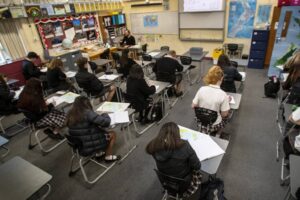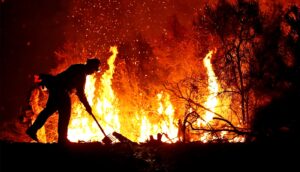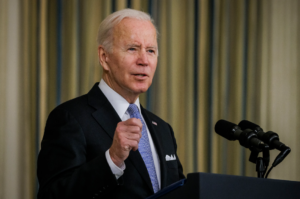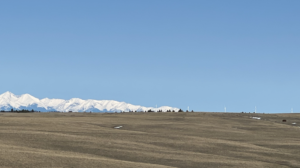The Federal Government Gives Native Students an Inadequate Education, and Gets Away With It
16 min read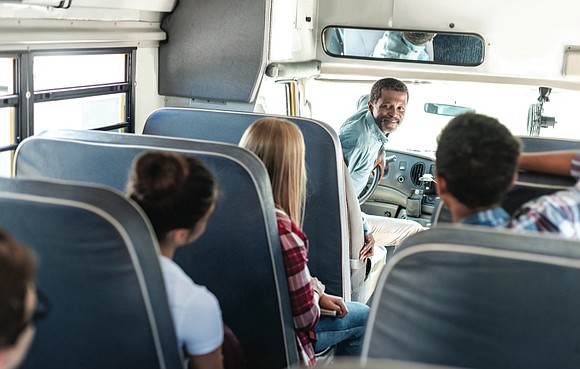
ProPublica is a Pulitzer Prize-winning investigative newsroom. Sign up for The Big Story newsletter to receive stories like this one in your inbox.
A couple of months after Kimasha Shorty’s son started sixth grade at an Arizona public middle school, his teachers called her at home. He had trouble adding and subtracting and was struggling to read at grade level.
Shorty didn’t understand how it was possible that her oldest child could be so far behind after leaving Wide Ruins Community School, the sole elementary school in an area of about 1,000 residents at the southern edge of the Navajo Nation. He had been diagnosed with a mild learning disability that affects reading and math comprehension, but Shorty said he was doing so well by fourth grade that he skipped a grade at the urging of administrators and began attending a public middle school about 25 miles south in Sanders.
There, her son was far behind his classmates, many of whom did not grow up in his rural community and didn’t spend their early years at an elementary school overseen by the Bureau of Indian Education, a little-known federal agency that manages more than 180 schools and dormitories across the country.
Year after year, a similar pattern emerged for Shorty, the mother of nine children. Her daughter’s middle school math class started with geometry, but her fifth grade at the elementary school had barely touched long division.
In February, months after another son started at a public middle school, Shorty received a call from a school counselor seeking a meeting to discuss his academic performance. The meeting never happened because the coronavirus pandemic forced the school to close. As Shorty waits to hear when her son can return, she worries that he is falling further behind.
“It’s a really huge disappointment,” said Shorty, 37, who still has three children at Wide Ruins. “Honestly, I’m afraid.”
Leaders at Wide Ruins did not return multiple calls seeking comment.
The BIE produces some of the lowest academic results in the country and has allowed school buildings to go years in disrepair. But perhaps one of its biggest failures has been a history of repeatedly neglecting warnings that it is not providing a quality education for the 46,000 students who attend its schools, which operate primarily on reservations and are often the only available option in rural communities.
About 90% of Native American students attend traditional public schools. But in many rural communities on reservations, schools managed by the BIE are the only option.
A review of hundreds of documents and dozens of interviews with parents, school employees and tribal officials by The Arizona Republic and ProPublica detail how the agency has either disregarded, ignored or delayed efforts meant to end its pattern of failing Native American children.
For the past three years, the bureau failed to comply with key components of the Every Student Succeeds Act, the nation’s primary education law, which mandates that states and the BIE adopt uniform standards for student learning and accountability and sets requirements for transparency.
As a result, the BIE is the only education system in the country that hasn’t implemented a plan to hold schools accountable for student performance. While its students take standardized tests, the schools have for years administered two dozen different exams, leaving the agency unable to compare scores in different states and monitor systemwide performance. And the bureau doesn’t publish federally mandated school report cards, which provide parents with information from academic scores to teacher qualifications to the frequency and severity of student discipline.
Even more striking, the U.S. Department of Education warned the agency for the past 13 years that it was shortchanging special education students, meaning some children went from kindergarten to graduation without the BIE making changes that could improve their education.
The bureau is one of several federal offices whose failure to correct intractable shortcomings has continued a pattern of pervasive inequities for Native American communities.
The Indian Health Service, a federal system of hospitals and health centers that serves more than 2.6 million patients, has repeatedly been found to provide substandard care, exacerbating health disparities for Native American patients. Most recently, an investigation by The Wall Street Journal and the PBS series “Frontline” found that IHS allowed a pediatrician to continue practicing for two decades, transferring him from one hospital to another, despite reports that he was sexually abusing his patients.
Federal officials have acknowledged deficiencies in both systems, but reforms have been arduously slow. Decades of promises from the administrations of multiple presidents and both political parties have done little to change the outcomes for students attending the bureau’s schools.
A fractured system of oversight extends the blame beyond BIE to the U.S. Department of the Interior, which is responsible for the agency, and to the Education Department, which regularly identifies serious problems in the bureau’s academic programs but allows them to persist. The Education Department does not directly manage the agency, but it monitors how the agency manages academic programs for which the department provides funding, including special education.
“It’s not acceptable in the United States of America for an entity (the Department of the Interior) that’s responsible for this to allow this kind of thing to go on,” said Sally Jewell, the former interior secretary under President Barack Obama. While the deficiencies continued during the time Jewell led the department, she defended the work done during her tenure, adding that success takes time and must build upon previous reform efforts.
Pointing to the poor education system as a reason for extreme poverty on Native American reservations throughout the country, a group convened by Jewell and Arne Duncan, then the U.S. Secretary of Education, released a report in 2014 that called the BIE a “stain on our Nation’s history” and expressed an urgent need for reforms.
Known as the Blueprint for Reform, the plan promised to transform the agency by giving tribes more control over schools and focusing the BIE’s efforts on providing resources, direction and services to help students attain high levels of achievement.
Tony Dearman, the current director of the BIE, said the education system has made improvements in the years since the plan.
The BIE previously had to go through its parent agency, the Bureau of Indian Affairs, to enter into contracts, make large purchases and inspect its school buildings. Now, the BIE has assumed those responsibilities, giving it the ability to better serve schools, said Dearman, a member of the Cherokee Nation who joined the agency as a science teacher in Oklahoma and worked as a principal, superintendent and regional leader before he was appointed director in 2016.
But Dearman told The Arizona Republic and ProPublica that he didn’t know if academics improved systemwide during the same period.
“That’s the first time I’ve had that question,” Dearman said in an October interview. He declined subsequent interview requests through a spokeswoman, who did not answer detailed questions.
In a school year abruptly ended by the novel coronavirus pandemic, many parents and tribal leaders worry that the long-standing gaps between students at bureau schools and those in traditional public schools will only widen.
When the coronavirus forced schools to close, Shorty’s seventh grader, who attends an Arizona public middle school, received a laptop from the school. Most days, he logged into Google Classroom, an online file-sharing service for schools, and worked through batches of lessons.
His younger siblings attending Wide Ruins didn’t have that option. The elementary school sent two paper packets in two months with assignments that the children quickly plowed through.
Shorty, whose work driving people to medical appointments largely dried up, downloaded educational phone applications and encouraged her kindergartener to practice his ABCs while they waited for more packets from the school.
The packets never arrived.
“Set Up for Failure”
For decades, the federal government’s system for educating Native children was to send them to boarding schools, many far from tribal communities, where teachers and administrators tried to erase students’ culture and force them to assimilate.
Years after the policy ended, the federal government transformed the school system into the Bureau of Indian Education.
Stretching across 23 states, the BIE operates unlike any education system in the country. It is solely funded by federal dollars and run by the Interior Department, an agency with little educational expertise that is primarily tasked with overseeing national parks and natural resources.
Many of the schools it oversees sit hundreds of miles apart, spread out across reservations larger than some eastern states. Roads are often impassable during storms, cell service is spotty and internet access is unreliable in many communities.
In some ways, the bureau acts like a school district, directly controlling staffing and budgets for about a third of its schools. In other cases, it operates like a state, providing funds and oversight for schools, like Wide Ruins, that are operated by sovereign tribal governments or local school boards.
Any attempt to improve an educational system built on a foundation of discrimination must involve fundamentally reenvisioning the agency’s mission, Duncan said.
“It was set up for failure,” Duncan, the education secretary under Obama, said of the BIE. “It wasn’t broken. To say it’s broken is to let everybody off the hook.”
Six of the past nine presidents have either pledged to improve Native students’ education or proposed reforms intended to address crumbling buildings, train more Native American teachers and give tribes greater control over educating children.
In 1970, President Richard Nixon called the federal government’s approach to education for Native American students among “the saddest aspects of Indian life,” pointing to dropout rates that were twice the national average. President Bill Clinton later said revamping Native education was “vital.”
And in 2014, Obama ordered his administration to create new educational opportunities for Native students, including those in BIE schools, telling his staff, “You will make sure that this happens under my watch.”
That year, the Obama administration had listening sessions with tribes across the country, eventually releasing the Blueprint for Reform, a sweeping plan for changing the BIE. The plan concluded that its proposed changes reflected the belief that all students, especially children attending BIE schools, could learn because “accepting anything less says nothing about these students, but rather speaks volumes about a failure of leadership and political will.”
Six years later, school leaders say little has changed.
“If you take a look at the BIE test scores, academic scores, they are disheartening. They will make you wonder. You will sit there, numb,” said Tommy Lewis, who retired last fall from the Navajo Nation’s tribal education department after six years at the helm. “Why are our Native students not being given a quality education when the goal is world-class?”
Only about 15% of BIE students passed their school’s standardized English exam in the 2018-19 school year and only 1 in 10 passed in math, according to documents shared with tribal leaders and obtained by The Arizona Republic and ProPublica.
That year, the graduation rate for BIE schools was 59%, a point shy of where it was in 1969, when a Senate subcommittee’s report called Native education “a national tragedy,” citing a severe lack of funding and capable staff.
The graduation rate dropped from 64% in 2017-18, the most recent year for which nationwide comparison data is available. During the same period, public school students had an 85% graduation rate, while Native American students, the vast majority of whom attend traditional public schools, had a 74% graduation rate.
The results do not provide a full picture of performance across the bureau’s schools because the BIE does not follow the transparency requirements that apply to every public school in the country. The BIE acknowledged in a 2019 report to the Education Department that it reports academic performance results that “may not be valid nor reliable.”
The Arizona Republic and ProPublica filed a public records request in September 2019 with the BIE for academic performance data from its schools, but the agency has yet to provide the information. Such data is publicly available for all other traditional public school systems in the country.
Education experts said the absence of academic data makes it difficult to hold the federal government accountable and, ultimately, harms Native American children.
“I think certain populations, certain schools become invisible,” said Sean Reardon, a Stanford University professor who studies the relationship between socioeconomic inequality and educational opportunity. “They never get attention because you can’t say anything with certainty about them.”
Havasupai Elementary is one of those schools. Situated on the floor of the Grand Canyon, where it’s accessible only by helicopter or an 8-mile hike, the school languished for years. In 2017, nine students and their families sued the BIE in federal court, accusing the agency of “longstanding educational deprivations.”
Educators teach as many as three grades at once at the chronically understaffed school. Students don’t get necessary special education services and only about 20% go on to graduate from high school, according to interviews and records from an ongoing court battle now in its fourth year.
BIE argued in court that it is hamstrung by the school’s remote location.
“In an ideal world, yes, this would be great. This school could have it all,” Lisa Olson, an attorney for the federal government, said in court. “But this is the real world, with real budget constraints that make such an endeavor not feasible.”
Two of six claims remain in the case after U.S. District Judge Steven Logan determined that some were too broad and that BIE is not required to follow every regulation set by the Department of Education because it is controlled by a separate federal agency.
The case is set to go to trial in November, but the judge already ruled that BIE violated its responsibility to provide students with disabilities access to education through services that include therapists and individualized special education plans.
Operating in the Dark
If Shorty’s youngest children were old enough to ride the bus 30 minutes away, she would send them to a public elementary school in a neighboring community.
Those schools are also among the state’s worst performers. But at the public schools, at least, Shorty would have access to basic information about student performance and programs.
Shorty checked the grades earned by each local public school. With a few more taps on her phone, she could access the public schools’ report cards and learn how many of the schools’ teachers were fully certified, how often the school issued discipline and whether its special education students kept pace with their peers.
At Wide Ruins, she can only guess.
In 2015, Congress replaced No Child Left Behind with a new law that maintained the requirement for mandatory standardized testing but allowed states to set their own standards for student performance and accountability.
Under the law, known as the Every Student Succeeds Act, or ESSA, states and the BIE had until the start of the 2017-18 school year to develop plans that ensured students took the same standardized test and outlined the steps they would take to identify and fix schools that were not meeting performance goals.
BIE missed the deadline by three years. In 2018, the year after the plan was first due, the Education Department withheld at least $1.6 million in administrative funding. It later released the money after the BIE showed progress toward completing a plan.
“This is an essential and fundamental component of the educational system and is already seriously delayed,” Assistant Secretary for Elementary and Secondary Education Frank Brogan wrote to the BIE in November 2018.
Similar warnings followed, but The Arizona Republic and ProPublica were unable to determine if the Education Department issued additional sanctions.
Education Department officials declined to answer detailed questions about the delays and the steps taken to hold BIE accountable. In a statement, spokesman Eli Mansour said only that the agency was working closely with the Department of the Interior to bring BIE schools into compliance with federal requirements.
The Department of Education “doesn’t know how to take care of BIE,” said Don Yu, an education attorney who worked in both the Education Department and BIE during the Obama administration. It “works with regular public school systems. BIE is totally different.”
In March, the BIE released a plan that would begin to bring the accountability that Shorty wants at Wide Ruins.
The plan would require every school to follow the same academic standards for what students at each grade level will be learning.
In July, the BIE signed a contract with a testing company to purchase exams that the agency said all of its students would take this school year. The agency expects to roll out the full plan over the next four years, placing it far behind every other school system in the country. Even then, tribes can seek an exemption from the secretaries of education and the interior and create their own plan, which would prevent the BIE from moving forward with a unified accountability system.
By the time a plan is fully implemented, Shorty’s kindergartner will be nearing the end of his time at Wide Ruins. Her youngest, who is 2, will be starting at the school.
“We say that we’re our children’s voice,” Shorty said. “How are we our children’s voice if we don’t know these things or share them with each other?”
“Stupid to Trust Them”
Miles away from Shorty, in another part of the Navajo Nation, Carletta Lee believed she had taken all of the necessary steps to make sure that her son, Jacob, a fourth grader with a learning disability, succeeded at the school she herself had attended while growing up.
Lee, 44, was elected to serve on the advisory board for Beclabito Day School, a BIE-operated campus that sits just a few miles past the Arizona state line in New Mexico.
Lee advocated to ensure her son, who was diagnosed with attention deficit hyperactivity disorder, known as ADHD, and a learning disability that affects his math and reading skills, had access to the special education services that he was entitled to under the law. That included having a special education teacher visit his classroom for one-on-one help with math three times a week. In 2016, a school employee quietly alerted Lee that her son wasn’t getting the services.
Lee requested copies of Jacob’s records, which showed that he received special education services on days that he was absent from school. The school also claimed academic achievements that Lee had not seen in her son.
“It was saying he passed on learning how to count money, telling time, all these things, and I was like, ‘There’s no way,’” Lee said. “He didn’t know how to do those things.”
Lee found a lawyer and filed a complaint with the BIE, requesting an investigation. She said the school had refused to include her in a meeting that determined what services Jacob would receive as a special education student.
Her son, she recalled, had gone four months without services to which he was entitled.
Situations like Lee’s, while often unreported, are not rare.
Twenty years ago, the Education Department issued a report that found BIE didn’t comply with federal special education law. The report warned that the education system didn’t adequately prepare students for life after high school graduation.
For the past 13 years, the Education Department found serious flaws in the BIE’s special education program, including incomplete academic data and schools that neglected to prepare students for adult life. And in each of the past nine years, the BIE’s special education programs received a “needs intervention” designation, which is reserved for states that have either severe fiscal and data problems or poor academic results. It is the only education system in the country that has been on the list for nearly a decade.
Over and over, the Education Department required the BIE to submit improvement plans, each time saying more enforcement wasn’t necessary because it believed the problems would take only a year to solve.
Last year, after eight consecutive warnings, the Education Department withheld $780,000 in administrative funding from the BIE. The Education Department told government investigators that the BIE was only the second education system to receive such a sanction. The other was the District of Columbia, which in 2009 had 20% of its special education administrative funding withheld after needing intervention for three consecutive years.
“The feds have been very gentle on BIE for the performance measures,” said Harvey Rude, a professor emeritus at Northern Colorado University and member of a board that advises the BIE on its special education programs. The agency’s inability to comply with federal law, he said, is inexcusable, adding, “There’s just not much of an appetite for accountability.”
This year, the U.S. Government Accountability Office found that BIE special education students did not receive 20% of the service time they were entitled to under the law. The figure could be larger, according to the report, which said that BIE schools did not have documentation to show whether students received another 18% of service time.
After an investigation into Lee’s case, BIE found that Beclabito’s only special education teacher wasn’t fully qualified for her position and that Jacob likely didn’t get required services. School records indicating Jacob received services were of “questionable veracity,” the investigation found.
Beclabito’s principal said budget and staffing shortages, along with a lack of qualified applicants, made it difficult to hire licensed staff, according to the investigation. The principal did not return calls seeking comment.
The BIE required Beclabito to provide Jacob with 60 hours of extra special education services. By then, he’d moved to Nenahnezad Community School, another BIE-operated campus about 40 miles east.
The extra hours weren’t enough to make up for the time he’d lost, Lee said.
This fall, Jacob will start high school. He’ll enter ninth grade, his mother said, reading at the level of a fifth grader. He’s even further behind in math.
“I put a lot of trust in the school,” Lee said. “I put trust in the school that they were going to be providing the services, that they knew what they were doing. I think the school relied on a parent’s ignorance, that they wouldn’t question anything.”
“When I look back now at the time, I’m like, ‘Wow, I really was stupid to trust them,’” Lee said.
“Heartbreaking”
Shorty’s oldest son never caught up academically after leaving Wide Ruins.
His classmates in public school mocked him as he struggled to adjust. They called him dumb and told him to go back to elementary school, where they said he belonged.
The bullying crushed his interest in school. He bounced around local schools, working with his new teachers to close the gap. But he said it was too much to overcome.
A couple of weeks into his senior year in July 2016, the family faced a crippling tragedy. Shorty’s 3-year-old son was killed by a pack of dogs. Her oldest son dropped out of high school.
He’s now 21 and an aspiring police officer who reads at about a fifth-grade level, Shorty said. He and his two younger sisters, who also dropped out, recently enrolled in an online program to finish high school.
“Even to fill out an application, sometimes, he has a hard time,” Shorty said. “To see him like that, it’s heartbreaking.”
Shorty, who earned a GED after her own schooling stopped at eighth grade, fears her youngest children will follow the same path: Behind from the beginning, their potential stifled by a failing school system.
“In the end, the kids are the ones that are hurting,” Shorty said.
This article The Federal Government Gives Native Students an Inadequate Education, and Gets Away With It was initially published by Propublica

